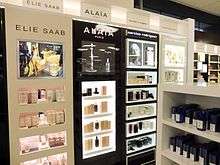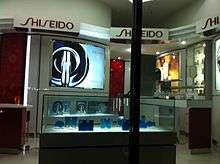Shiseido
|
| |
Native name | 株式会社資生堂 |
|---|---|
Romanized name | Kabushiki-gaisha Shiseidō |
| Public (K.K.) | |
| Traded as |
TYO: 4911 OTCQX: SSDOY OTCQX 30 component Topix large 70 component |
| Industry | Consumer goods |
| Founded | 1872 |
| Headquarters | Chūō, Tokyo, Japan |
Key people |
Shinzo Maeda, President and CEO (ending April 1, 2014) Late Masahiko Uotani, President and CEO (April 1, 2014-2016)[1] |
| Products | Cosmetics |
| Revenue |
|
|
| |
Number of employees | 33,356 (2013) |
| Subsidiaries |
Bare Escentuals Beaute Prestige International |
| Website | shiseido.com |
Shiseido Company, Limited (株式会社資生堂 Kabushiki-gaisha Shiseidō) (Japanese: [ɕiseeꜜdoː]) is a Japanese multinational personal care company, that is a skin care, hair care, cosmetics and fragrance producer. It is one of the oldest cosmetics companies in the world. Founded in 1872, it celebrated its 140th anniversary in 2012.[2][3] It is the largest cosmetic firm in Japan and the fifth largest cosmetics company in the world.[4] Shiseido is only available at cosmetic counters at selected department stores or pharmacists. The company owns numerous brands and subsidiaries worldwide, in addition to its founding label. The company trades on the Tokyo stock exchange, and it is a chief competitor of SK-II.
History
Arinobu Fukuhara, former head pharmacist to the Japanese Imperial Navy, established the Shiseido Pharmacy in 1872. After a visit to the United States and Europe, Arinobu added a soda fountain to the store. This later grew into the Shiseido Parlour restaurant business, and eventually led to the introduction of ice cream in Japan. The name "Shiseido" can be translated as "praise the virtues of the earth which nurtures new life and brings forth significant values".[5]
Shiseido was the first to develop the softening lotion, a lightweight liquid of toner-like consistency. The oldest softening lotion is named Eudermine, which is still marketed and sold at all Shiseido counters. The softening lotion was developed in response to lead poisoning, as the Japanese women used makeup based on white lead.
Timeline
In 1917, Shiseido introduced Rainbow Face Powder. This was a face powder with seven colors in a period when white face powders were the norm in Japan.[6] In 1923, the company began expanding its store-base; it now has approximately 25,000 outlets. A joint-stock company was formed in 1927.
In 1957, Shiseido began sales in Taiwan, closely followed by Singapore and Hong Kong. In 1962, Shiseido expanded to Hawaii; in 1965, it established Shiseido Cosmetics America. European sales began with Italy in 1968 and Oceania with New Zealand in 1971.[7]
In 1985, Shiseido was the first company to produce sodium hyaluronate (hyaluronic acid/hyaluronan) from non-animal origin sources.[8] In North America and Europe, Shiseido products are sold in major department stores, pharmacies, and specialty Asian retailers.
The company is embroiled in controversial animal testing in China and in America's Long Island based third party based testing company, lead usage in make-up, Shiseido Shock controversy related to unethical treatment of beauty advisors and women, displacement of factory workers after suddenly shutting down facilities, unethical removal of Chinese Sales team and more recently poaching three top executives from beauty player Coty despite they being legally bound by contractual obligations. In December 2016 over 400,000 customer credit card and other financial details were leaked for the company's ipsa brand online store data base in Japan making it a major breach in customer trust.
Finances and operations
In the first quarter of 2013, Shiseido had a net profit of 2.66 billion yen or USD $26.87 million on sales of 162.36 billion yen, or $1.64 billion.[9] On 15 July 2013, Shiseido announced it was opening a wholly owned subsidiary in India.[10] On 20 February 2014, Shiseido agreed to sell its Carita and Decléor brands to L’Oréal for €227.5 million (USD$312.93 million (2014) as it couldn't manage to capture the French market or understand the brands' potential; this sale resulted in Shiseido showing profits despite running into losses.[11]
In February 2016, Masahiko Uotani was replaced as the CEO.
Current skincare products
In Japan, Shiseido sells Elixir Superieur skincare products for women, Aqua Label skincare and toiletry products for daily use, Uno skincare products for men, Clé de Peau Beauté makeup, skin and body care, Benefique skincare and Anessa suncare lines.
Make-up
In Japan, Shiseido sells Benefique pre-makeup and foundation products, Maquillage full-line makeup counselling-based (with a beauty advisor) products, and Integrate full-line makeup self-selection-based (no sales staff) products.
In China, aside from Maquillage, Shiseido also sells Aupres, its major makeup brand there.
Elsewhere, Shiseido produces a line of cosmetics simply called "The Makeup" that provide a full range of products including lip products, powder eye shadows, eye liner pencils, mascara, fluid and compact foundations, concealers, and powder blush. Their hydro powder eye shadows which have a creamy texture are among Allure magazine's top beauty picks.[12]
Company portfolio subsidiaries

- In addition to producing products under the Shiseido brand, Shiseido also has several other subsidiaries and brands.
- Aupres is a line of cosmetics and skincare products made and sold exclusively in China.
- Ayura, this brand was sold to a Japanese pharmacy company with all employees in 2015
- Bare Escentuals
- Beauté Prestige International, based in Paris, France, produces perfumes under the Issey Miyake, Narciso Rodriguez, Elie Saab, and Azzedine Alaïa brands. BPI also was responsible for launching Jean-Paul Gaultier fragrances, but the licence expired in 2015.
- Clé de Peau offers skincare, makeup and bodycare. The most popular item from Cle de peau is the concealer, along with Clé de Peau Beauté.[13]
- d-program offers skincare and makeup for sensitive skin.
- Aqualabel
* Dolce and Gabbana- Personal care and fine fragrances (as of July 2016) - Za
- IPSA
- Shiseido Professional Hair
- Joico
- NARS Cosmetics
- Qiora
- Revital, line targeting women in their 30s-40s
- Senscience
- Shiseido
- Serge Lutens
- UNO, line for men.
- UV White
- Zotos International
Shiseido also once owned ZIRH International, a New York City-based producer of men's skincare and fragrance products under the ZIRH and Corduroy brands. In September 2007, Shiseido sold ZIRH back to an investment group owned by Brian Robinson, the former president of ZIRH.
Notes
- ↑ Weil, Jennifer (24 December 2013). "Shiseido Names New President and CEO". WWD. Retrieved 26 December 2013.
- ↑ SHISEIDO Frequently Asked Questions - SHISEIDO USA - FAQ 1.
- ↑ Five Good-Looking Cosmetic Stocks - Seeking Alpha
- ↑ Japan's Shiseido Agrees to Acquire Bare Escentuals - WSJ.com
- ↑ COSMETICS - Shiseido - VEPA GROUP
- ↑ About Shiseido - BANBATSU SHISEI (The Origins)
- ↑ History. Shiseido Group.
- ↑ SHISEIDO Sodium Hyaluronate :History - shiseido.co.jp
- ↑ Wetherille, Kelly (July 31, 2013). "Shiseido Swings to Black in Q1". WWD. Retrieved 31 July 2013.
- ↑ Wetherille, Kelly (July 19, 2013). "Shiseido Sets Subsidiary in India". WWD. Retrieved 31 July 2013.
- ↑ Kaiser, Amanda (19 February 2014). "Shiseido Sells Carita, Decléor to L'Oréal". WWD. Retrieved 20 February 2014.
- ↑ Allure Best of Beauty 2008 - Allure.com
- ↑ Clé de Peau Beauté
References
External links
| Wikimedia Commons has media related to Shiseido. |
- Shiseido Global (English)
- Shiseido – brand and company profile at Fashion Model Directory
- Shiseido launch charity auction for Japan tsunami victims
